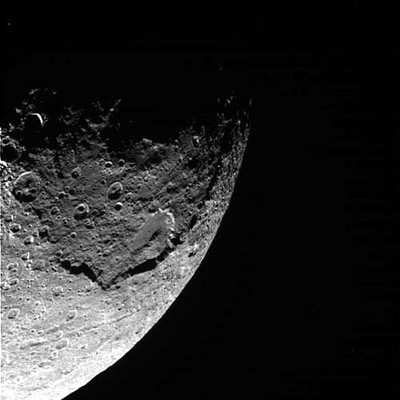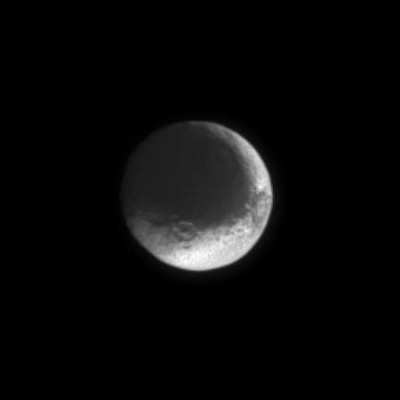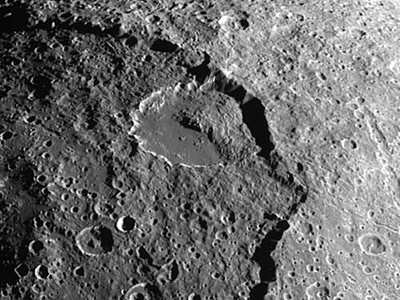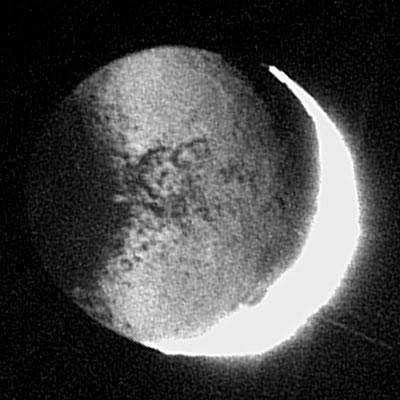Mon, Jan 10, 2005
Or Are You Just Happy We're In Orbit?
Images returned by NASA's Cassini spacecraft cameras during a
New Year's Eve flyby of Saturn’s moon Iapetus
(eye-APP-eh-tuss) show startling surface features that are fueling
heated scientific discussions about their origin.

One of these features is a long narrow ridge that lies almost
exactly on the equator of Iapetus, bisects its entire dark
hemisphere and reaches 20 kilometers high (12 miles). It extends
over 1,300 kilometers (808 miles) from side to side, along its
midsection. No other moon in the solar system has such a striking
geological feature. In places, the ridge is comprised of mountains.
In height, they rival Olympus Mons on Mars, approximately three
times the height of Mt. Everest, which is surprising for such a
small body as Iapetus. Mars is nearly five times the size of
Iapetus.

Iapetus is a two-toned moon. The leading hemisphere is as dark
as a freshly-tarred street, and the white, trailing hemisphere
resembles freshly-fallen snow.
The flyby images, which revealed a region of Iapetus never
before seen, show feathery-looking black streaks at the boundary
between dark and bright hemispheres that indicate dark material has
fallen onto Iapetus. Opinions differ as to whether this dark
material originated from within or outside Iapetus. The images also
show craters near this boundary with bright walls facing towards
the pole and dark walls facing towards the equator.

Cassini's next close encounter with Iapetus will occur in
September 2007. The resolution of images from that flyby should be
100 times better than the ones currently being analyzed. The hope
is that the increased detail may shed light on Iapetus’
amazing features and the question of whether it has been
volcanically active in the past.

With a diameter of about 1,400 kilometers (890 miles), Iapetus
is Saturn's third largest moon. It was discovered by Jean-Dominique
Cassini in 1672. It was Cassini, for whom the Cassini-Huygens
mission is named, who correctly deduced that one side of Iapetus
was dark, while the other was white.
More News
Aero Linx: JAARS Nearly 1.5 billion people, using more than 5,500 languages, do not have a full Bible in their first language. Many of these people live in the most remote parts of>[...]
'Airplane Bounced Twice On The Grass Runway, Resulting In The Nose Wheel Separating From The Airplane...' Analysis: The pilot reported, “upon touchdown, the plane jumped back>[...]
"Burt is best known to the public for his historic designs of SpaceShipOne, Voyager, and GlobalFlyer, but for EAA members and aviation aficionados, his unique concepts began more t>[...]
"Polaris Dawn, the first of the program’s three human spaceflight missions, is targeted to launch to orbit no earlier than summer 2024. During the five-day mission, the crew >[...]
There Are SO Many Ways To Get YOUR Aero-News! It’s been a while since we have reminded everyone about all the ways we offer your daily dose of aviation news on-the-go...so he>[...]
 ANN's Daily Aero-Linx (05.04.24)
ANN's Daily Aero-Linx (05.04.24) NTSB Final Report: Quest Aircraft Co Inc Kodiak 100
NTSB Final Report: Quest Aircraft Co Inc Kodiak 100 Aero-News: Quote of the Day (05.04.24)
Aero-News: Quote of the Day (05.04.24) Aero-News: Quote of the Day (05.05.24)
Aero-News: Quote of the Day (05.05.24) Read/Watch/Listen... ANN Does It All
Read/Watch/Listen... ANN Does It All






